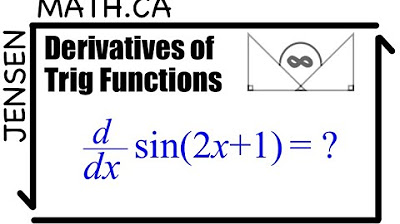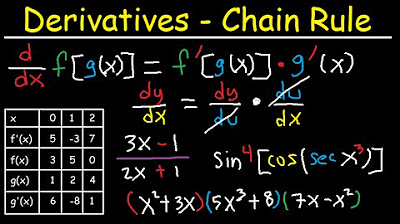Math 1325 Lecture 9 7 - Using Derivative Forumulas
TLDRThe lecture focuses on the application of derivative formulas in calculus, specifically the power rule, sum and difference rule, product rule, quotient rule, and chain rule. The power rule is introduced as the simplest, where the derivative of a variable raised to a power involves bringing the power down as a multiplier and subtracting one from the exponent. The sum and difference rule allows for the derivative of a sum or difference of functions by taking the derivative of each part and then adding or subtracting. The product rule and quotient rule are more complex, involving multiplication of derivatives and division by the square of the denominator, respectively. The chain rule is used for composite functions. The lecture emphasizes the importance of attention to detail and practice, as these rules can be combined in complex ways. Examples are provided to illustrate the application of these rules, highlighting the need for careful algebraic manipulation to simplify the expressions. The summary encourages students to practice these techniques to prepare for tests and to be meticulous in their calculations.
Takeaways
- 📚 The Power Rule: When differentiating a function of the form x^n, bring the exponent down as a multiplier and subtract one from the exponent (e.g., derivative of x^3 is 3x^2).
- 🔢 The Sum and Difference Rule: Differentiate each term of a sum or difference separately and then add or subtract the results (e.g., derivative of x^3 - x^2 is 3x^2 - 2x).
- 🤝 The Product Rule: For a product of two functions, the derivative is the derivative of the first times the second plus the first times the derivative of the second.
- 🔄 The Quotient Rule: For a quotient of two functions, the derivative is (derivative of the numerator times the denominator minus the numerator times the derivative of the denominator) divided by the denominator squared.
- 🏗 The Chain Rule: When differentiating a composite function, take the derivative of the outer function and multiply it by the derivative of the inner function.
- ⚙️ Constant Rule: The derivative of a constant is 0, and the derivative of a constant times a function is the constant times the derivative of the function.
- 🧩 Combination of Rules: Complex derivatives often require using a combination of the above rules, paying close attention to detail and taking the time to work through each step.
- 📐 Simplification: After applying the derivative rules, it's important to simplify the expression, which may involve combining like terms and converting between exponents and roots.
- 📈 Practice: The lecturer emphasizes the importance of practicing these rules, especially for more complex problems, to prepare for tests.
- 📋 Use of Scratch Paper: It's recommended to use plenty of scratch paper and be neat to avoid missing terms and to facilitate checking work.
- 🚧 Caution: The process of differentiating complex functions can be daunting at first but with practice, it becomes clearer and more manageable.
Q & A
What is the power rule for derivatives?
-The power rule states that if you have a function f(x) = x^n, the derivative f'(x) is n*x^(n-1). It involves bringing the power down in front as a multiplier and subtracting one from the exponent.
How does the sum and difference rule apply to derivatives?
-The sum and difference rule allows you to take the derivative of a function that is a sum or difference of two functions by taking the derivative of each part separately and then adding or subtracting them as they appear in the original function.
What is the product rule for derivatives and how does it differ from the power rule?
-The product rule is used when a function is a product of two other functions. It states that the derivative of such a function is the derivative of the first function times the second function plus the first function times the derivative of the second function. It differs from the power rule in that it involves a multiplication of functions rather than a single function raised to a power.
Explain the quotient rule for derivatives.
-The quotient rule is used for functions that are a quotient of two other functions. It states that the derivative is the derivative of the numerator times the denominator minus the numerator times the derivative of the denominator, all divided by the denominator squared.
What is the chain rule and when is it used?
-The chain rule is used for composite functions, where f(x) = g(h(x)). It states that the derivative of f(x) is the derivative of g(h(x)) times the derivative of h(x), or f'(x) = g'(h(x)) * h'(x).
What is the derivative of a constant?
-The derivative of a constant is always zero because constants do not change with respect to the variable.
How can you simplify the derivative of a quotient raised to a power?
-You can simplify by first taking the derivative of the outer function using the power rule and then applying the quotient rule to the inner function. Afterward, you can combine like terms and simplify the expression by canceling out common factors.
What is the strategy for solving complex derivative problems that involve multiple rules?
-The strategy involves breaking down the problem into smaller parts, applying the appropriate rule for each part (power rule, product rule, quotient rule, chain rule), and then combining the results. It's important to pay attention to detail and use plenty of scratch paper to keep track of the steps.
Why is it important to practice derivative calculations even if they are complex?
-Practice is essential for becoming comfortable with the rules and procedures involved in derivative calculations. It helps to build problem-solving skills and ensures readiness for more complex problems and tests.
How can you handle a complex derivative problem that involves both a product rule and a chain rule?
-First, identify the parts of the function that require the product rule and the chain rule. For the product rule, find the derivative of each factor and combine them according to the rule. For the chain rule, find the derivative of the outer function times the derivative of the inner function. Then, combine these results, being careful to apply the correct mathematical operations.
What is the role of algebraic manipulation in simplifying derivatives?
-Algebraic manipulation is crucial for simplifying derivatives, especially when dealing with complex expressions. It involves combining like terms, reducing fractions, and converting between radical and exponential forms to arrive at a more straightforward and understandable result.
What is the advice given for approaching complex derivative problems?
-The advice given is to take your time, use a lot of paper for a clear step-by-step process, pay attention to detail to avoid missing any terms, and check your work multiple times to ensure accuracy.
Outlines
📚 Derivative Rules and Formulas Overview
This paragraph introduces the lecture on derivative formulas, emphasizing the combination of rules to solve more complex derivative problems. It reviews the power rule, sum and difference rule, product rule, quotient rule, and chain rule for composite functions. The importance of attention to detail and the use of scratch paper is highlighted. An example involving the derivative of x cubed minus x squared is provided to illustrate the application of these rules.
🔍 Applying the Quotient Rule and Chain Rule
The focus of this paragraph is on applying the quotient rule and chain rule to more complex functions, specifically composite functions involving quotients. It discusses the process of differentiating the outer and inner functions separately and then combining the results. An example of a quotient raised to a power is given, and the listener is encouraged to pause and attempt the problem before continuing. The solution involves using both the quotient rule for the inner function and the power rule for the outer function, resulting in a simplified expression.
🧮 Advanced Derivative Problems with Quotients and Powers
This paragraph delves into more complicated derivative problems involving quotients with powers. It outlines the process of differentiating both the numerator and the denominator of a quotient, each of which is a composite function. The paragraph provides a detailed example that requires the use of both the quotient rule and the chain rule. The solution process involves simplifying the expression, which can be complex due to the multiple steps and exponents involved. The emphasis is on practicing these more challenging problems to prepare for tests.
📈 Derivatives of Products and Composite Functions
The final paragraph discusses the derivative of a product of two functions, one of which is a composite function under a radical. It explains the process of turning radicals into exponentials to simplify the differentiation process. The paragraph uses the product rule and the chain rule to find the derivative of the given function. An example is provided, and the solution involves simplifying the expression by moving terms and canceling out common factors. The importance of being meticulous with algebra and checking work is stressed to avoid simple mistakes.
Mindmap
Keywords
💡Derivative
💡Power Rule
💡Sum and Difference Rule
💡Product Rule
💡Quotient Rule
💡Chain Rule
💡Composite Function
💡Constant Rule
💡Simplifying Expressions
💡Attention to Detail
💡Practice
Highlights
The lecture covers derivative formulas and their combinations to solve more complex problems.
The power rule states to bring the power down as a multiplier and subtract 1 from the exponent.
The sum/difference rule involves taking the derivative of each function and adding/subtracting them.
The product rule is (derivative of first function * second function) + (first function * derivative of second function).
The quotient rule is (derivative of numerator * denominator) - (numerator * derivative of denominator) / denominator squared.
The chain rule is used for composite functions by taking the derivative of the outer function times the derivative of the inner function.
Derivatives of constants are 0, and constants can be factored out by multiplying by the derivative of the function.
Combining rules requires time, attention to detail, and practice for solving more complex derivative problems.
The chain rule is used for composite functions with a quotient as the inner function, demonstrated through an example.
The quotient rule is applied to the inner function when the outer function is a power, as shown in an example.
The numerator and denominator derivatives are calculated separately when applying the quotient rule to a quotient of two powers.
Radicals can be converted to exponentials to simplify finding derivatives using the power rule and chain rule.
The product rule is used when the first factor is not a composite function, and the second factor involves a composite function under a radical.
Negative exponents indicate terms should be moved to the denominator, and fractional exponents in the denominator should be converted to roots.
Attention to detail is crucial to avoid simple mistakes when combining derivative rules and solving complex problems.
Using lots of paper, being neat, and double-checking work can help ensure accuracy in solving derivative problems.
Transcripts
Browse More Related Video

Derivatives of Polynomial Functions: Power Rule, Product Rule, and Quotient Rule

Derivatives of Trig Functions - Calculus | MCV4U

Math 1325 Lecture 9 4 - Derivative Formulas

Derivatives of Composite Functions: The Chain Rule

Derivatives of Composite Functions - Chain Rule, Product & Quotient Rule

The Chain Rule - Part 2
5.0 / 5 (0 votes)
Thanks for rating: